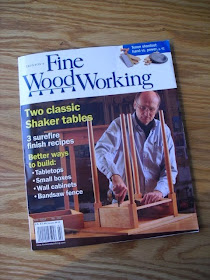
These door panels measure roughly 14 x 41, so I used those dimensions as a starting point for the cabinet. Since this cabinet is also going to hold some bathroom supplies on it's shelves, I decided to make the two adjustable shelves out of melamine covered MDF, with a solid cherry edge to match the rest of the cabinet. Melamine isn't exactly glamorous material for a piece of furniture, but if that bottle of glass cleaner or cleanser leaks, clean-up is much easier.

Of course, I had to rout a graceful curve on the top. The cabinet might not be in a place of prominence, but there's no sense in making it boring.
The top looks like it needs another coat of Watco.

My local Festool guru loaned me a Domino to play with, and this cabinet was a perfect opportunity to try it out. I have to admit - this piece went together in minutes, as opposed to hours. And as much as I want to complain about the price of the Domino, I am quickly seeing the merits of owning one.
Guess I'll be re-working my tool budget for 2010 and trying to fit this tool into my arsenal.






















































